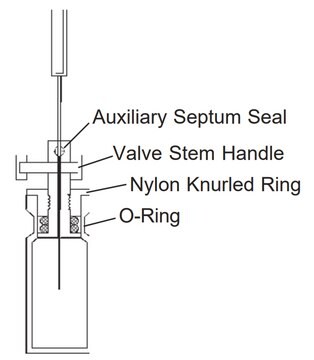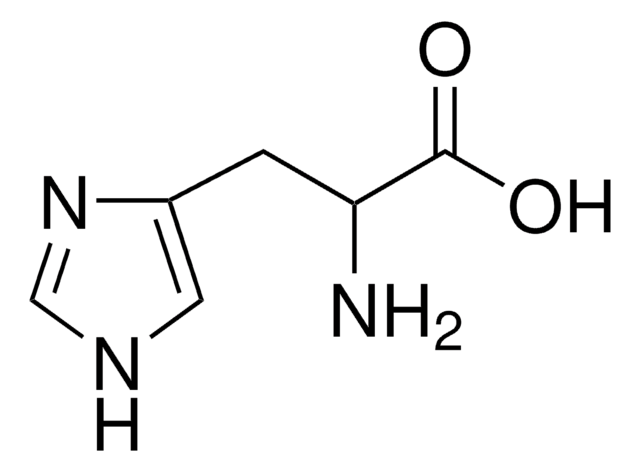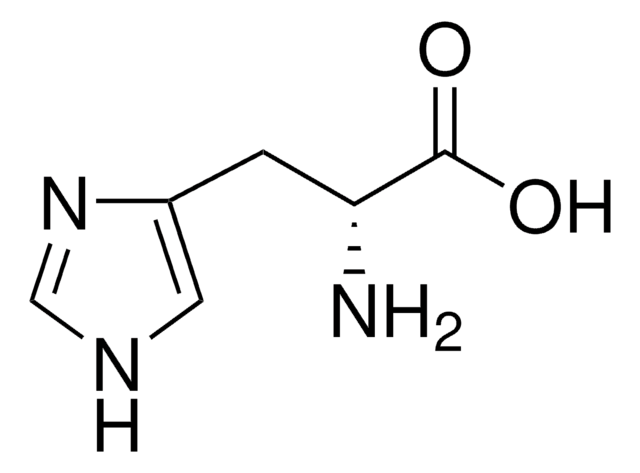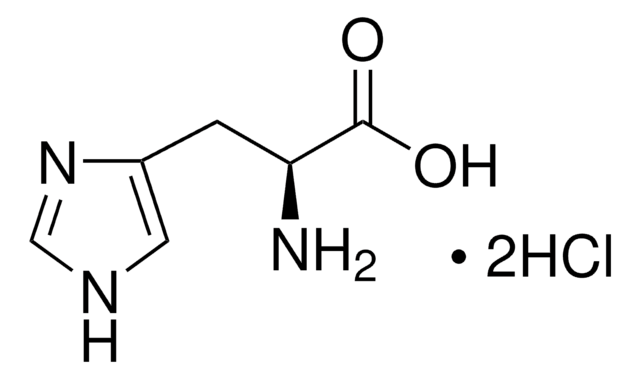Kluczowe dokumenty
53319
L-Histidine
≥99.5% (NT), BioUltra
Synonim(y):
(S)-2-Amino-3-(4-imidazolyl)propionic acid, NSC 137773
About This Item
Polecane produkty
Nazwa produktu
L-Histidine, BioUltra, ≥99.5% (NT)
linia produktu
BioUltra
Poziom jakości
Próba
≥99.5% (NT)
Formularz
powder or crystals
aktywność optyczna
[α]20/D −39±1°, c = 2% in H2O
zanieczyszczenia
insoluble matter, passes filter test
≤0.5% foreign amino acids
pozostałość po prażeniu
≤0.1% (as SO4)
strata
≤0.5% loss on drying, 110 °C
kolor
white
pH
7.0-8.0 (25 °C, 0.1 M in H2O)
mp
282 °C (dec.) (lit.)
~285 °C (dec.)
rozpuszczalność
H2O: 0.1 M at 20 °C, clear, colorless
ślady anionów
chloride (Cl-): ≤100 mg/kg
sulfate (SO42-): ≤100 mg/kg
ślady kationów
Al: ≤5 mg/kg
As: ≤0.1 mg/kg
Ba: ≤5 mg/kg
Bi: ≤5 mg/kg
Ca: ≤10 mg/kg
Cd: ≤5 mg/kg
Co: ≤5 mg/kg
Cr: ≤5 mg/kg
Cu: ≤5 mg/kg
Fe: ≤5 mg/kg
K: ≤50 mg/kg
Li: ≤5 mg/kg
Mg: ≤5 mg/kg
Mn: ≤5 mg/kg
Mo: ≤5 mg/kg
NH4+: ≤500 mg/kg
Na: ≤50 mg/kg
Ni: ≤5 mg/kg
Pb: ≤5 mg/kg
Sr: ≤5 mg/kg
Zn: ≤5 mg/kg
λ
0.1 M in H2O
absorpcja UV
λ: 260 nm Amax: 0.05
λ: 280 nm Amax: 0.05
ciąg SMILES
N[C@@H](Cc1c[nH]cn1)C(O)=O
Zastosowanie
detection
InChI
1S/C6H9N3O2/c7-5(6(10)11)1-4-2-8-3-9-4/h2-3,5H,1,7H2,(H,8,9)(H,10,11)/t5-/m0/s1
Klucz InChI
HNDVDQJCIGZPNO-YFKPBYRVSA-N
Szukasz podobnych produktów? Odwiedź Przewodnik dotyczący porównywania produktów
Zastosowanie
Działania biochem./fizjol.
Inne uwagi
Zastosowanie
Kod klasy składowania
11 - Combustible Solids
Klasa zagrożenia wodnego (WGK)
WGK 1
Temperatura zapłonu (°F)
Not applicable
Temperatura zapłonu (°C)
Not applicable
Środki ochrony indywidualnej
Eyeshields, Gloves, type N95 (US)
Wybierz jedną z najnowszych wersji:
Masz już ten produkt?
Dokumenty związane z niedawno zakupionymi produktami zostały zamieszczone w Bibliotece dokumentów.
Klienci oglądali również te produkty
Chromatograms
application for HPLCNasz zespół naukowców ma doświadczenie we wszystkich obszarach badań, w tym w naukach przyrodniczych, materiałoznawstwie, syntezie chemicznej, chromatografii, analityce i wielu innych dziedzinach.
Skontaktuj się z zespołem ds. pomocy technicznej






